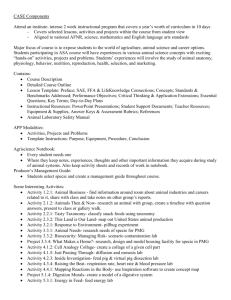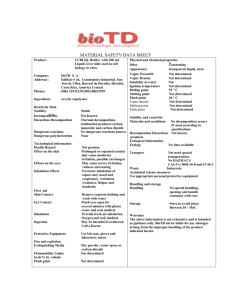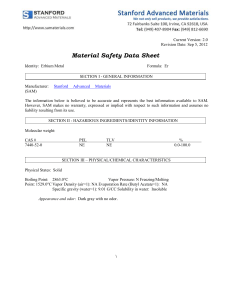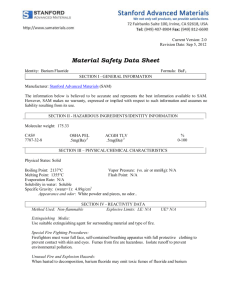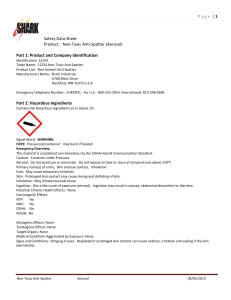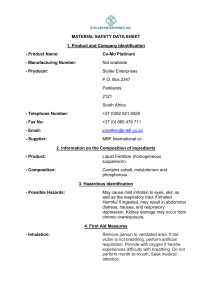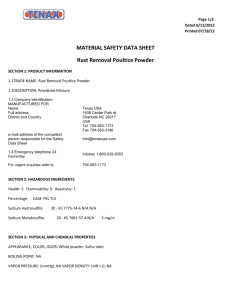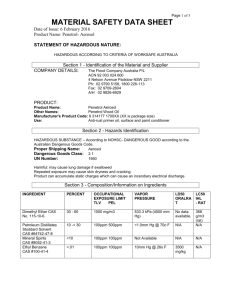product safety data sheet
advertisement
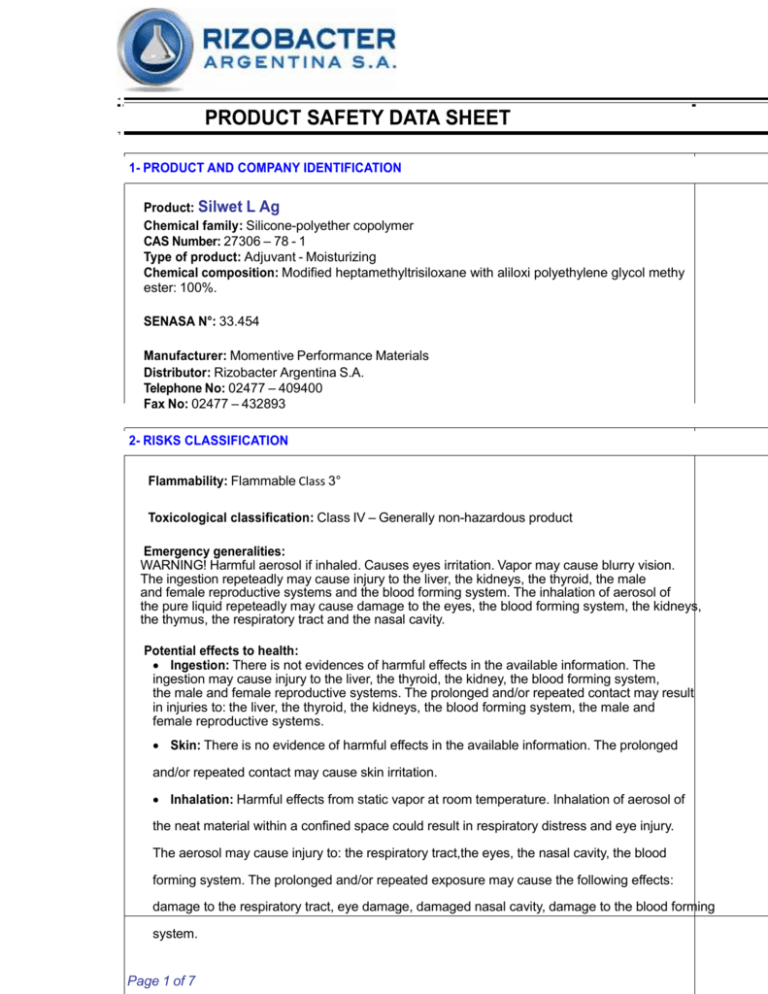
PRODUCT SAFETY DATA SHEET 1- PRODUCT AND COMPANY IDENTIFICATION Product: Silwet L Ag Chemical family: Silicone-polyether copolymer CAS Number: 27306 – 78 - 1 Type of product: Adjuvant - Moisturizing Chemical composition: Modified heptamethyltrisiloxane with aliloxi polyethylene glycol methy ester: 100%. SENASA N°: 33.454 Manufacturer: Momentive Performance Materials Distributor: Rizobacter Argentina S.A. Telephone No: 02477 – 409400 Fax No: 02477 – 432893 2- RISKS CLASSIFICATION Flammability: Flammable Class 3° Toxicological classification: Class IV – Generally non-hazardous product Emergency generalities: WARNING! Harmful aerosol if inhaled. Causes eyes irritation. Vapor may cause blurry vision. The ingestion repeteadly may cause injury to the liver, the kidneys, the thyroid, the male and female reproductive systems and the blood forming system. The inhalation of aerosol of the pure liquid repeteadly may cause damage to the eyes, the blood forming system, the kidneys, the thymus, the respiratory tract and the nasal cavity. Potential effects to health: Ingestion: There is not evidences of harmful effects in the available information. The ingestion may cause injury to the liver, the thyroid, the kidney, the blood forming system, the male and female reproductive systems. The prolonged and/or repeated contact may result in injuries to: the liver, the thyroid, the kidneys, the blood forming system, the male and female reproductive systems. Skin: There is no evidence of harmful effects in the available information. The prolonged and/or repeated contact may cause skin irritation. Inhalation: Harmful effects from static vapor at room temperature. Inhalation of aerosol of the neat material within a confined space could result in respiratory distress and eye injury. The aerosol may cause injury to: the respiratory tract,the eyes, the nasal cavity, the blood forming system. The prolonged and/or repeated exposure may cause the following effects: damage to the respiratory tract, eye damage, damaged nasal cavity, damage to the blood forming system. Page 1 of 7 Created with novaPDF Printer (www.novaPDF.com). Please register to remove this message. Eyes: Liquid splashed into the eyes may cause discomfort. It may cause the following effects: pain, excessive linking, tear production, excessive conjunctival redness, swelling of the conjunctivae. These effects should be resolved within two weeks. It may occur injury to the cornea. Prolonged exposure to vapor or aerosol may cause discomfort. Vapor may cause blurry vision. These effects will be resolved within a few hours. Medical conditions aggravated: A knowledge of the available toxicology information and of the physico-chemical properties of the material suggests that is unlikely that overexposure aggravate existing medical conditions. Sub chronic (Target organ): Unknown. Chronic effects / carcinogenicity: For additional information, please see Section 8, Toxicological information. Routes of exposure: Eyes; Inhalation. 3- PHYSICAL AND CHEMICAL PROPERTIES Physical state: Liquid Color / Odor : Light yellow / Moderated, to polyether Specific weight 20 º C / 20 º C : 1.0070 Solubility in water (20 °C): Dispersable Vapor pressure (20 °C): < 1 mm Hg Boiling point: > 150 º C Vapor density (Air=1): Heavier than air Decomposition temperature: Not determined 4- FIRST AIDS Inhalation: Take the patient to a ventilated place. Artificial oxygen may be required. Provide medical assistance. Skin: Wash immediately with abundant water and soap while taking off contaminated clothing and shoes. If symptoms persist, provide medical assistance. Eyes: Rinse immediately with abundant water, also under eyelids for at least 15 minutes. Provide medical assistance if symptoms persist. Ingestion: If the person is conscious, give him/her abundant water. Provide immediate medical assistance. Physician note: Severe eye irritation. The treatment is symptomatic and supportive. Page 2 of 7 5- MEDIDAS CONTRA EL FUEGO Ignition point: Method: Flammable limits in air - Lower (%): Flammable limits in air - Higher (%): Sensitibity to mechanical shock: Sensitibity to static discharge: 116 °C; 241 °F ASTM D 93 Not available Not available Not expected Not expected Fire extinguishing media: All common extinguishing agents are are suitable. Special fire fighting procedures: Firefighters must wear NIOSH/MSHA approved positive pressure self-contained breathing apparatus with full face mask and full protective clothing. 6- STORAGE AND HANDLING Engineering controls: Use only in an area equipped with security showers; Eye wash basin; It is necessary that the ventilation of the general area (mechanic) was satisfactory if managed at low temperatures or in a covered equipment; Special local ventilation is needed in places where it is considered that vapors may escape to the working environment. Respiratory protection: Respirator with filter ABEK; in high concentrations use respiratory protection with independent air supply. If exposure limits are exceeded or respiratory irritation is experienced, NIOSH/MSHA approved respiratory protection must be worn. Supplied air respirators may be needed for non-routine or emergency situations. Respiratory protection must be provided according to OSHA regulations (see 29CFR 1910.134). Protective gloves: Impermeable or chemical-resistant gloves. Eyes and face protection: Lateral protection safety glasses. Another protective equipment: Wear proper protective clothing and eyes/face protection. Precautions as regards handling and storage: Avoid skin and eyes contact. Keep away from children. Attention: Do not inject humans. It may generate formladehyde at temperatures higher than 150 °C. Other precautions: Consult to the manufacturer before using a pure liquid aerosol. Storage: Keep the contained closed. Store in its original container. 7- STABILITY AND REACTIVITY Stability: Stable Hazardous polymerization: It will no occur. Hazardous thermal decomposition / Combustion products: In case of combustion, oxides of carbon, silicon oxides and formaldehyde will be released; carbon monoxide is highly toxic if inhaled; carbon dioxide in sufficient concentration may act as asphysxiant; acute overexposure to products may result in respiratory tract irritation. This product contains methylpolysiloxanes that may generate formaldehyde at approximately 300 °F(150°C) and above in atmospheres containing oxygen. Formaldehyde is a skin and respiratory sensitizer, eyes and throat irritatant, acute toxicant, and potential cancer hazard. Incompatibility (materials to be avoided): Not known. Conditions to be avoided: Not known. 8- TOXICOLOGICAL INFORMATION Acute oral: LD50; Specie: Rat.; > 2,000 mg/kg; Remarks: Very low toxicity Acute dermal: LD50; Specie: Rat.; > 2,000 mg/kg; Remarks: Very low toxicity Acute inhalation: LC50; Specie: Rat.; 2 mg/l; Remarks: Aerosol LC50; Specie: Rat.; > 11.78 mg/l; Remarks: Aerosol, 5% diluted aqueous solution. Other: This material was not mutagenic in the Ames test or in three test system to mammals, including the Chinese hamster ovary (CHO), HPRT gene mutation test , a micronucleous cytogenitic assay in mice and a mammalian in vitro cytogenetic assay. In a repeated skin application study with rats, this material proved moderate skin irritation that was resolved during a post-application recovery period. There was no evidence of percutaneous cumulative or specific organs toxicity, and no effects on the male and female reproductive systems. Findings from a 14-day dietary feeding study with rats show that high dosage repeated ingestion of this materia causes reversible adverse effects on the male and female reproductive tracts. Additional effects seen include increased liver weight, altered blood cytology/chemistry, and thyroid enlargement (primarily hypertrophy, with some hyperplasia). Evidence of partial or complete recovery was found over a 28-day recovery period. Findings from a repeat 9-day aerosol inhalation toxicity study with rats show a no-observable-effectlevel (NOEL) of less than 0,025 mg/l. Symptoms of toxicity included rales, gasping, ocular opacity, prostration, hypothermia, reduced body weight gain and food consumption, changes in clinical pathology, decreased thymus weight, and microscopic lesions in the nasal cavity. There was no effect on the male and female reproductive systems. It is not anticipated that the use of aqueous dilutions of this product would result in this type of aerosol exposure. Sensitization: Specie: guinea pigs; Result: it did not cause sensitization. Skin irritation: Specie: Rabbit; Result: No irritation Eye irritation: Specie: Rabbit; Result: Slight irritation Other effect of overexposure: No adverse effects anticipated from available information. Page 4 of 7 9- ECOTOXICOLOGICAL INFORMATION Ecotoxicology: It is expected this product to be toxic to aquatic organisms. It may cause long-term adverse effects in the aquatic environment. Toxicity to fish: LC50 Specie: Zebra fish Dose: 2,75 mg/l Exposure time: 96 h NOEC Specie: Zebra fish Dose: 0,56 mg/l Exposure time: 96 h Toxicity to other organisms Inmobilization EC50 Specie: Daphnia similis Dose : 22,61 mg/l Exposure time: 48 h NOEC Specie: Daphnia similis Dose: 10 mg/l Exposure time: 48 h Toxicity to algae EC50 Specie: Selenastrum capricornutum Dose: 5.5 mg/l Exposure time: 96 h NOEC Specie: Selenastrum capricornutum Dose: 1 mg/l Exposure time: 96h Information regarding elimination (persistence and degradability) Biodegradability: Not readily biodegradable. 10- EMERGENCY ACTIONS Actions to be taken if material is released or spilled: Wipe, scrape or soak up in an inert material and put in a container for disposal. Wash walking surfaces with detergent and water to reduce slipping hazard. Wear proper protective equipments. Elimination method: Elimination should be carried out according to federal, state and local regulations. Page 5 of 7 11- TRANSPORT INFORMATION DOT shipping name: Environmentally hazardous substances, liquid, n.o.s.(Polyalkyleneoxide Modified Heptamethyltrisiloxane). DOT hazard class: 9 DOT label(s): 9 UN/NA number: UN3082 NA3082 Packing group: III IMDG Shipping name: Environmentally hazardous substances, liquid, n.o.s.(Polyalkyleneoxide Modified Heptamethyltrisiloxane). Class: 9 IMDG labels: 9 UN Number: UN3082 Packing group: III EmS No.: F-A; S-F IATA: Environmentally hazardous substances, liquid, n.o.s.(Polyalkyleneoxide Modified Heptamethyltrisiloxane). Class: 9 ICAO Labels: 9MI UN Number: UN3082 Packing group: III 12- OTHER INFORMATION CONTACT IN CASE OF POISONING: · NATIONAL POISON CENTER - Hospital Nacional "Prof. Alejandro Posadas " President Illia and Marconi Av CP 1684 - El Palomar - Province of Buenos Aires TEL: 0-800-333-0160 (011) 4654-6648 (011) 4658-7777 Type of assistance: personal and telephone within 24 hours. · Toxicology Unit - Hospital de Niños "Dr. Ricardo Gutiérrez" Gallo 1330 CP 1425 - Ciudad Autónoma de Buenos Aires TEL: (011) 4962-2247 / 6666 Type of assistance: personal and telephone within 24 hours. · T.A.S. - Toxicology Consulting and Services CP 1544 Tucumán 2000 - Rosario - Santa Fe Province of TEL: (0341) 424-2727 448-0077 Type of assistance: personal and telephone within 24 hours. · Toxicology Service - Hospital Escuela "José de San Martín" Paraguay 2201 CP 1120 - Ciudad Autónoma de Buenos Aires TEL: (011) 5950-8804 / 8806 Type of assistance: personal and telephone within 24 hours. · CIQUIME - Chemistry Information Center for Emergencies TEL: 0800-222-2933 (011) 4613-1100 Type of Assistance: Call 24 hours. · Toxicology Service - Municipal Emergency Hospital Catamarca 441 CP 5000 - Córdoba TEL: (0351) 4276200 Type of assistance: personal and telephone within 24 hours. COMMENTS: Rizobacter Argentina S.A. assumes no implicit or explicit responsibility for damages of any nature, arising from a use other than indicated on the product label and not recommended precautions have been observed or not to keep it under normal conditions of storage.


